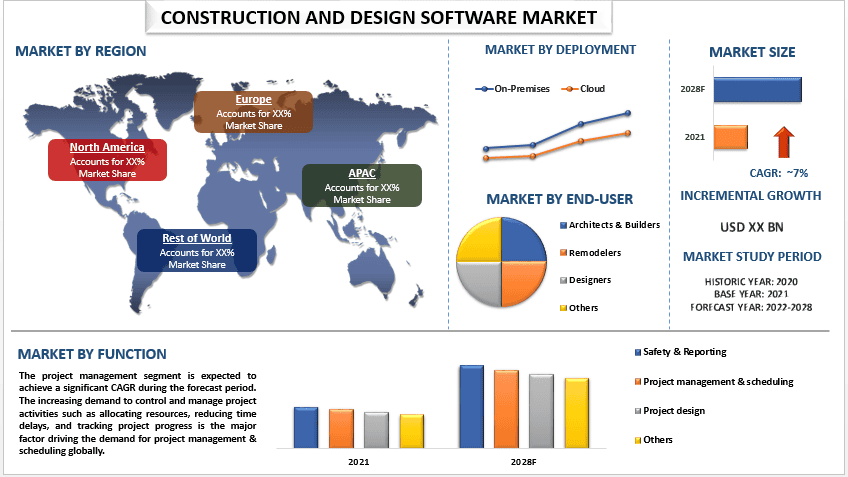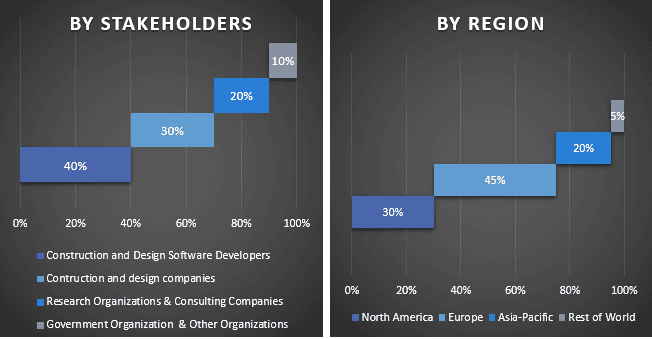- Home
- About Us
- Industry
- Services
- Reading
- Contact Us
Construction and Design Software Market : Current Analysis and Forecast (2022-2028)
Emphases on, Functions (Safety & Reporting, Project Management, Project Design, Field Service, and Others); Deployment (On-Premises, Cloud); End-Use (Architects & Builders, Remodelers, Designers, and Others); Region

Global Construction and Design Software Market is expected to grow at a significant rate of around 7% during the forecast period. The construction and software help organizations in design coordination, construction coordination, document management, budget management, communication, and decision-making. It aids in the deployment of new projects by incorporating specific business requirements.
Due to the expanding infrastructure activities, prompt completion of building tasks, integration with lean management processes, successful management, and financial visibility, the need for construction & design software would experience promising growth during the forecast period. Furthermore, the growing number of smart city initiatives are also contributing to the growth of the construction and design software market. A smart city deploys several electronic methods, sensors, and voice activation methods to obtain particular data the smart city focuses on the better engagement of its citizens for eco-friendly resource utilization construction and design software helps in ensuring the quality and performance of these devices. Moreover, construction and design software help in redefining the decision-making process in the construction of energy-efficient buildings and smart cities.
Bentley Systems, Vector works, Inc, Constellation Software Inc., Microsoft, Autodesk Inc, RIB Software SE, Sage Group plc, SAP, Trimble Inc., and Oracle Corporation. are some of the key players in the market. Several M&As along with partnerships have been undertaken by these players to facilitate customers with hi-tech and innovative products/technologies.
Insights Presented in the Report
“Amongst function, project management category accounted for the majority share in the market in 2021”
Based on function, the market is segmented into safety & reporting, project management, project design, and others. The project management segment achieved the highest market share and is expected to maintain a similar trend throughout the forecast period. The increasing demand to control and manage project activities such as allocating resources, reducing time delays, and tracking project progress is the major factor driving the demand for project management & scheduling globally.
“Amongst deployment, Cloud is expected to witness highest CAGR during the forecast period”
Based on deployment, the market is segmented into on-premises and cloud. During the forecast period, the cloud segment is expected to growth with a significant CAGR and is expected to maintain a similar trend throughout the forecast period. Due to the expanding infrastructure activities, prompt completion of building tasks, integration with lean management processes, successful management, and financial visibility, the need for construction & design software would experience promising futures. Furthermore, cloud solutions are easier to deploy and cost-effective.
“North America to witness significant growth during the forecast period”
North American regional market to witness significant growth during the forecast period. The regional growth can be attributed to the large-scale adoption of digital systems in the infrastructure domain and BIM by engineers, designers, architects, and builders. Furthermore, the role of governments in promoting the use of technology for the superior-quality of construction projects benefits the market in the region. For instance, the U.S. government announced a funding package worth USD 2 trillion, With this initiative, it is expected to boost the market growth, and subsequently increase the demand for construction and design software in the region.
Reasons to buy this report:
- The study includes market sizing and forecasting analysis validated by authenticated key industry experts.
- The report presents a quick review of overall industry performance at one glance.
- The report covers an in-depth analysis of prominent industry peers with a primary focus on key business financials, product portfolio, expansion strategies, and recent developments.
- Detailed examination of drivers, restraints, key trends, and opportunities prevailing in the industry.
- The study comprehensively covers the market across different segments.
- Deep dive regional level analysis of the industry.
Customization Options:
The global construction and design software market can further be customized as per the requirement or any other market segment. Besides this, UMI understands that you may have your own business needs, hence feel free to connect with us to get a report that completely suits your requirements.
Table of Content
Research Methodology for the Global Construction and Design Software Market Analysis (2022-2028)
Analyzing the historical market, estimation of the current market, and forecasting the future market of the global construction and design software market were the three major steps undertaken to create and analyze the adoption of construction and design software in major regions globally. Exhaustive secondary research was conducted to collect the historical market numbers and estimate the current market size. Secondly, to validate these insights, numerous findings and assumptions were taken into consideration. Moreover, exhaustive primary interviews were also conducted, with industry experts across the value chain of the global construction and design software market. Post assumption and validation of market numbers through primary interviews, we employed a top-down/bottom-up approach to forecasting the complete market size. Thereafter, market breakdown and data triangulation methods were adopted to estimate and analyze the market size of segments and sub-segments the industry pertains to. Detailed methodology is explained below:
Analysis of Historical Market Size
Step 1: In-Depth Study of Secondary Sources:
Detail secondary study was conducted to obtain the historical market size of construction and design software market through company internal sources such as annual report & financial statements, performance presentations, press releases, etc., and external sources including journals, news & articles, government publications, competitor publications, sector reports, third-party database, and other credible publications.
Step 2: Market Segmentation:
After obtaining the historical market size of the construction and design software market, we conducted a detailed secondary analysis to gather historical market insights and share for different segments & sub-segments for major regions. Major segments included in the report as function, deployment, and end-use. Further country-level analyses were conducted to evaluate the overall adoption of testing models in that region.
Step 3: Factor Analysis:
After acquiring the historical market size of different segments and sub-segments, we conducted a detailed factor analysis to estimate the current market size of construction and design software market. Further, we conducted factor analysis using dependent and independent variables such as various function, deployment and end-use, of construction and design software. A thorough analysis was conducted for demand and supply-side scenarios considering top partnerships, merger and acquisition, business expansion, and product launches in the Construction and design software market sector across the globe.
Current Market Size Estimate & Forecast
Current Market Sizing: Based on actionable insights from the above 3 steps, we arrived at the current market size, key players in the global construction and design software market, and market shares of the segments. All the required percentage shares split, and market breakdowns were determined using the above-mentioned secondary approach and were verified through primary interviews.
Estimation & Forecasting: For market estimation and forecast, weights were assigned to different factors including drivers & trends, restraints, and opportunities available for the stakeholders. After analyzing these factors, relevant forecasting techniques i.e., top-down/bottom-up approach was applied to arrive at the market forecast about 2028 for different segments and sub-segments across the major markets globally. The research methodology adopted to estimate the market size encompasses:
- The industry’s market size, in terms of revenue (USD) and the adoption rate of construction and design software market across the major markets domestically
- All percentage shares, splits, and breakdowns of market segments and sub-segments
- Key players in the global construction and design software market in terms of solutions offered. Also, the growth strategies adopted by these players to compete in the fast-growing market
Market Size and Share Validation
Primary Research: In-depth interviews were conducted with the Key Opinion Leaders (KOLs) including Top Level Executives (CXO/VPs, Sales Head, Marketing Head, Operational Head, and Regional Head, Country Head, etc.) across major regions. Primary research findings were then summarized, and statistical analysis was performed to prove the stated hypothesis. Inputs from primary research were consolidated with secondary findings, hence turning information into actionable insights.
Split of Primary Participants in Different Regions

Market Engineering
Data triangulation technique was employed to complete the overall market estimation and to arrive at precise statistical numbers of each segment and sub-segment of the global construction and design software market. Data was split into several segments & sub-segments post studying various parameters and trends in the areas of offering and technique in the global construction and design software market.
The main objective of the Global Construction and design software Market Study
The current & future market trends of the global construction and design software market were pinpointed in the study. Investors can gain strategic insights to base their discretion for investments on the qualitative and quantitative analysis performed in the study. Current and future market trends determined the overall attractiveness of the market at a regional level, providing a platform for the industrial participant to exploit the untapped market to benefit as a first-mover advantage. Other quantitative goals of the studies include:
- Analyze the current and forecast market size of the construction and design software market in terms of value (USD). Also, analyze the current and forecast market size of different segments and sub-segments
- Segments in the study include areas of function, deployment, and end-use.
- Define and analysis of the regulatory framework for the construction and design software market industry.
- Analyze the value chain involved with the presence of various intermediaries, along with analyzing customer and competitor behaviors of the industry.
- Analyze the current and forecast market size of the construction and design software market for the major region.
- Major countries of regions studied in the report include Asia Pacific, Europe, North America, and the Rest of the world.
- Company profiles of the Construction and design software market and the growth strategies adopted by the market players to sustain in the fast-growing market
- Deep dive regional level analysis of the industry
Related Reports
Customers who bought this item also bought










